I didn’t expect to be so moved by the heritage mansions of Chettinad. It was in the warm rustle of the Tamil Nadu wind and the red-ochre streets of Kanadukathan that I first encountered the heart of Chettinad.

At first glance, this corner of the Sivaganga district may appear like any other sleepy southern village, but then the ornate facades begin to rise before you—some hidden behind rusting gates, others proudly restored. These are more than heritage buildings; they’re storytellers of a great past.
The Legacy of the Chettiars
Chettinad, once the cradle of immense wealth and cosmopolitan vision, was built by the Nattukottai Chettiar community—merchant bankers who forged trade routes across Southeast Asia in the 19th and early 20th centuries. As their fortunes flourished through trade in gems, spices, and finance from Burma to Malaysia and Singapore, they returned home with more than riches. They brought back materials—Italian marble, Belgian mirrors, Burmese teak—and married them to traditional Tamil architecture to create what are now known as Chettinad mansions.
These mansions, known locally as periya veedu or big houses, were not only a measure of status but a functional and cultural nucleus for families that spanned seventy to eighty people. Their scale was enormous, with over fifty rooms often spread across more than an acre, built around three to four open courtyards. Designed to serve the social rhythm of the Chettiar life, they were the stage for weddings, births, festivals, and funerals. Every carved doorframe, every glinting chandelier, every cooling corridor spoke of ritual, refinement, and rootedness.
Past Perfect, Present Restored – Heritage Mansions of Chettinad
Walking through the entrance of Chettinadu Mansion in Kanadukathan, Tamil Nadu I felt that distinct echo of grandeur. Built in 1902, the home has now been transformed into a heritage hotel.

Twelve rooms stand restored with antique furniture, while the airy courtyards remain cooled by lime-and-egg plaster walls that have defied heat for generations. Nearby, Saratha Vilas in Karaikudi presents another side to Chettinad’s revival—one shaped by foreign eyes, lovingly restored by French architects who fell under the region’s spell. Here, Mediterranean design meets Tamil tradition in a quiet harmony, where the past greets the present with grace.
Another discovery was Chettinad Heritage in Nemathanpatti, a mansion over 120 years old. It has fourteen guest rooms and a kitchen where chefs work over open flames, grinding spices freshly under the same roof where they once prepared feasts for dowries and ceremonies. Live kitchens demonstrate ancestral cooking methods, and the fragrance of tamarind, pepper, and fennel lingers in the air long after the meals are served.
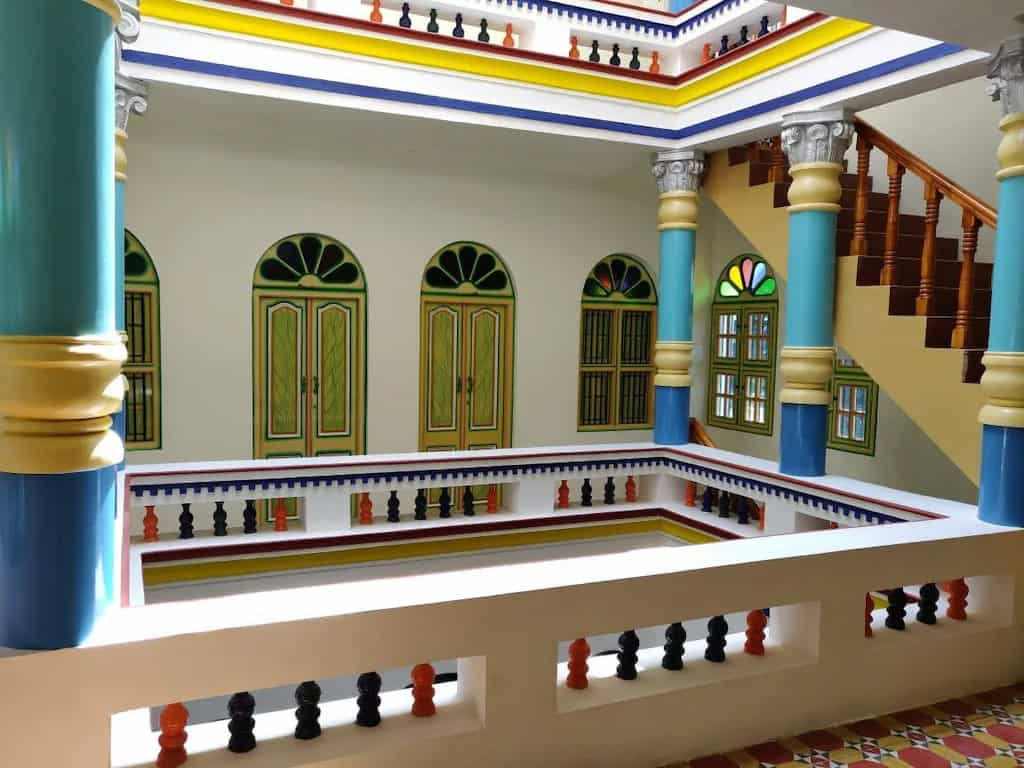
There was something soft about the quiet elegance of Visalam, (a CGH Hotel) a house that never quite became the home it was meant to be. I learned that it was built over a century ago by KVAL Ramanathan Chettiar as a loving gift for his eldest daughter, Visalakshi. The gesture alone—constructing an entire mansion for a daughter—spoke volumes about the Chettiar way of life: generous, grand, and grounded in tradition.
But Visalam, for all its beauty, stood mostly silent through the decades, used only for the occasional family gathering, like a memory preserved in plaster and teak. When it eventually changed hands, it came not just with history, but with an unspoken responsibility—to restore not just its walls, but the intention behind it. I could feel that sense of reverence in every corner of the home.
The high ceilings held echoes of unspoken conversations. The windows, polished lovingly, framed the Chettinad light just as they would have a hundred years ago. The furniture, all period pieces, felt more like heirlooms than décor. Each chair, each bedpost, carved from solid Burma teak, stood gracefully, as if aware of its lineage. And then there were the floors—oh, those floors. They carried the unmistakable shimmer of Athangudi tiles, made entirely by hand, still echoing the careful labour of generations of artisans.
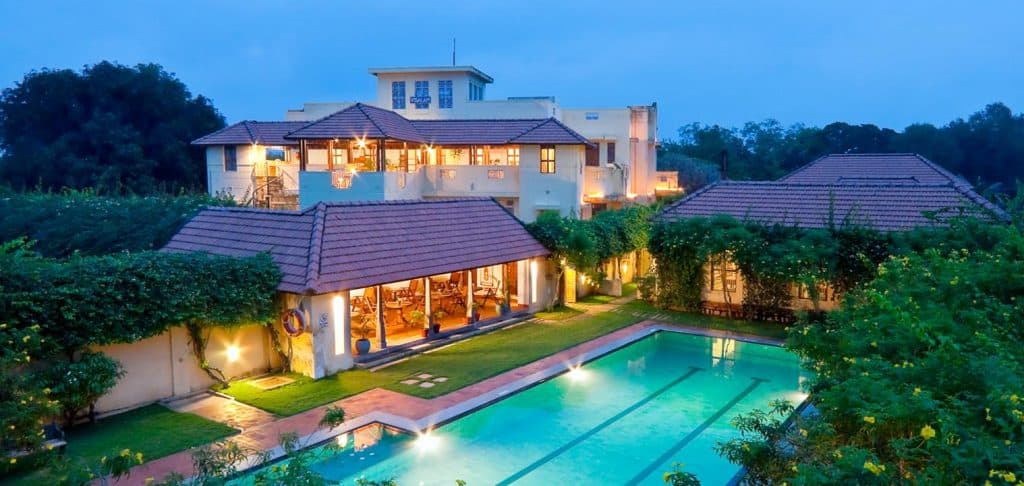
About ten kilometres from Visalam, in the village of Athangudi, I visited some of the very workshops where these tiles are still made today. Over a hundred small-scale factories continue the tradition, pouring colour, glass, and sand into intricate moulds with nothing but time and muscle memory guiding them. At Visalam, those same tiles are everywhere—not loud, not showy, just quietly magnificent.
Beyond the more familiar names like Chettinadu Mansion, Visalam, and the stately Raja’s Palace, I found myself stumbling upon other jewels—less talked about, perhaps, but no less grand in their bearing. There was the VVR Mansion in Kanadukathan, its red-sandstone façade glowing in the late afternoon light, and the famed 1000 Windows Mansion in Karaikudi, or Aayiram Jannal Veedu as the locals call it, a house that seems to breathe with every breeze that slips through its countless panes.
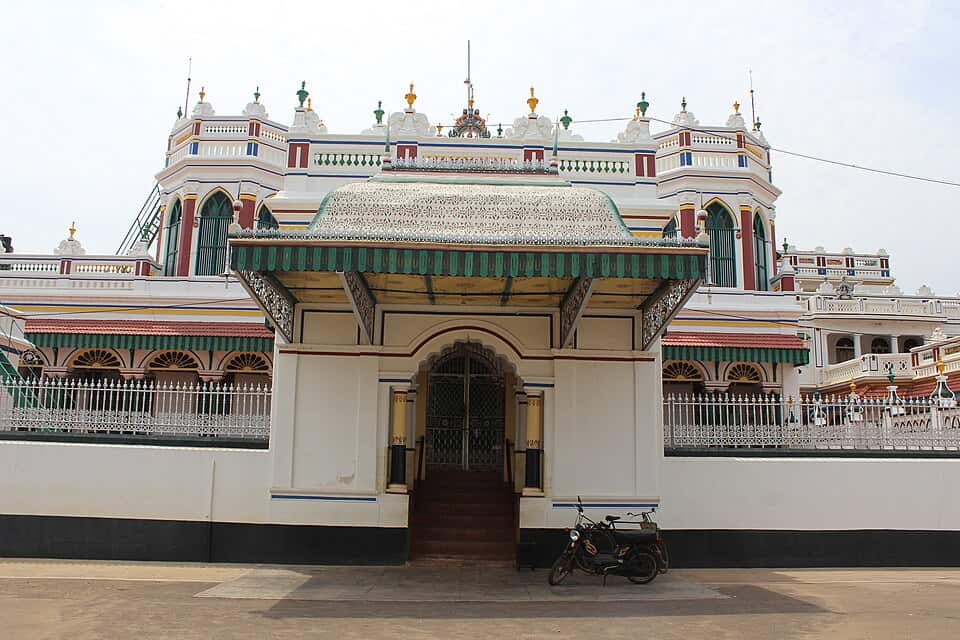
Both Kanadukathan’s Chettinad Palace and the Athangudi Palace stood like quiet guardians of a world that once knew no compromise in beauty. I walked their long corridors, tracing the faded grandeur still clinging to the walls.
Athangudi Palace stood with quiet dignity, surrounded by the very village that gave the iconic Chettinad tiles their name. Each of these homes, preserved or lovingly brought back to life in parts, carried the unmistakable imprint of Chettiar ambition and artistry. To walk through their pillared halls and tiled corridors was to witness a community’s legacy built not only in stone and wood but in vision, pride, and detail that has outlasted time itself.
Living in a Chettinad mansion
Living in a Chettinad mansion, even as a guest, is not just about luxury; it’s about immersion. In the mornings, I walked the red-soiled village lanes, sometimes in the company of bullock carts. Afternoons were spent visiting artisan homes where women wove Kandanghi saris in silence, the clatter of the loom weaving history into silk and cotton. I watched the intricate making of Athangudi tiles—each hand-poured, sun-dried, and painted in traditional floral and geometric patterns. These tiles, made from local sand and cement, are unique to the region, and their glossy finish now graces floors of both grand hotels and quiet ancestral homes.
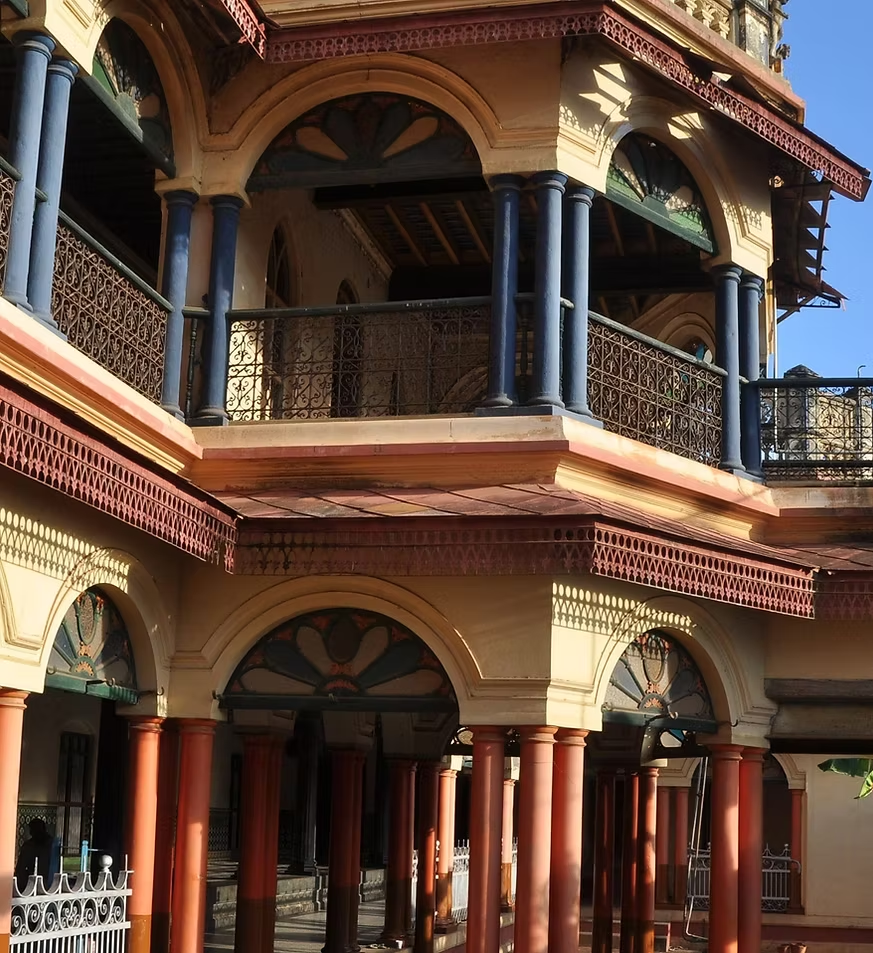
Everywhere I turned, there were whispers of the past. Some mansions had secret vaults, like Athangudi Periyaveedu, where iron doors, imported from England and bearing the British royal insignia, once guarded family fortunes. Visalam, another elegant property, was built as a dowry gift for a daughter who died before she could use it. These homes are layered with emotional histories, some locked away behind iron-barred gates, others polished back into life.
Weathered Walls, Unfading Grace
Today, only a tenth of the original 10,000 to 15,000 mansions remain intact, and fewer still operate as heritage resorts in Chettinad or as museums—perhaps under a hundred in total. The vast majority are decaying, caught in legal disputes or simply too expensive to maintain. About 30 percent are believed to have been completely destroyed, while 60 percent still stand, albeit in fragile conditions. Restoration is an expensive affair, and the government’s efforts are limited. Chettinad’s revival has been slow, driven by private families and passionate individuals rather than sweeping institutional support.
Rajasthan, by contrast, has embraced the heritage hotel concept on a larger scale, with iconic conversions like the Taj Lake Palace and Neemrana Fort Palace backed by significant state and commercial involvement. Chettinad’s efforts remain more intimate, community-driven, and deeply rooted in the storytelling of place.
But if Rajasthan is the grand theatre of Indian heritage hospitality, rich cultural heritage of Chettinad is the chamber recital—more subtle, less commercial, but no less profound.
Ancient Temples: The Soul of Chettinad Villages
Wandering deeper into the villages, I realised that in Chettinad, the spirit of the place isn’t just preserved in mansions and meals—it lives quietly in its temples. Each of the seventy-three villages holds its own Chola-style temple, weathered by time but still standing with a quiet, unwavering grace.
Their stone walls are darkened by age, their gopurams modest compared to the soaring towers of famous Tamil shrines, yet they carry a sacredness that feels deeply personal. Every temple has its own oorani, a tank that mirrors the sky, and around these waters, life seems to gather—the old men playing dice under banyan trees, women balancing brass pots on their hips, children splashing at the edges. In Chettinad, the temple is the village’s true heart, a silent witness to births, festivals, and the slow, unhurried passing of seasons.
A Meal, A Memory, A Ritual – Chettinad Style
Meals here are their own kind of ritual. At Chettinad Heritage, I sat down to a thali served on a banana leaf. There was the fiery Milagu Kozhi Varuval, or pepper chicken, slow-cooked with coconut and fennel. The mutton chukka, crisp and spice-laden, paired perfectly with flaky parotta. Prawns arrived simmered in a tangy tamarind-based gravy known as Karaikudi Eral Masala. I tasted nandu masala, a crab curry fragrant with star anise and kalpasi, the elusive black stone flower.
There were also vegetarian dishes like ennai kathirikai—brinjal in a thick tamarind gravy—and the unusual banana flower curry called vazhaipoo kuzhambu. Kuzhi paniyaram, those delicate crispy dumplings made from fermented rice and lentils, reminded me of Tamil Nadu’s deep-rooted culinary ingenuity. No meal was complete without paal payasam, a slow-cooked rice pudding infused with cardamom and jaggery. The flavours were complex, unapologetically bold, and rooted in land and memory.
In the quieter corners of Chettinad life, I discovered simple, timeless treats that told their own stories. At a village gathering, someone handed me a freshly fried murukku, its intricate coils crunching with a satisfying snap, spiced with cumin and black sesame seeds.
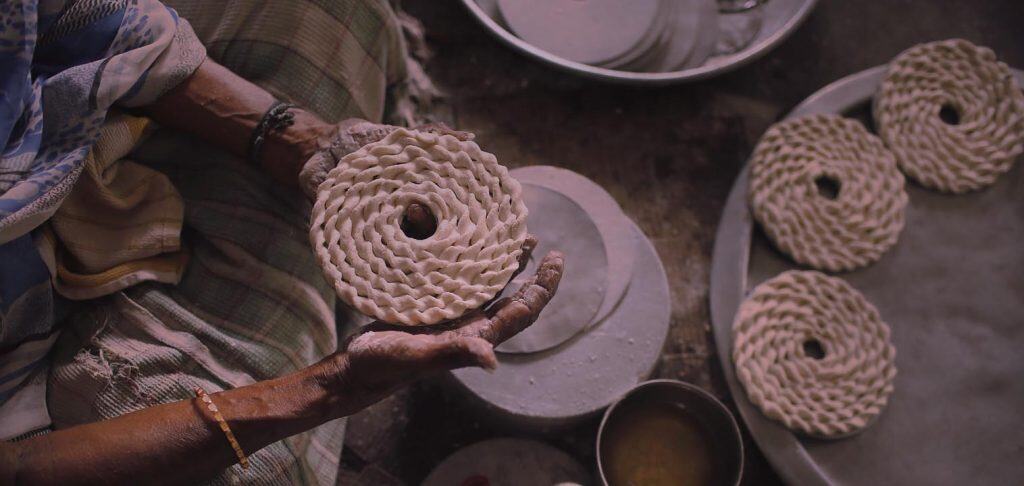
One evening, as the shadows stretched long across the village lanes, I was handed a small, fragrant bundle wrapped carefully in a banana leaf. Inside was kavanarisi, the black rice sweet that Chettinad holds close to its heart. Sticky, rich, and shimmering with jaggery and coconut milk, each bite tasted like a memory—earthy, slow-cooked, and impossibly tender. It wasn’t a dessert in the grand, polished sense; it was something humbler, older, like the soil itself had found a way to sing through food.
Paniyarams, too, appeared everywhere—golden, crisp on the outside, airy within—sometimes sweet, sometimes savoury, always made with the kind of care that only tradition teaches. One afternoon, sitting in the courtyard of a centuries-old mansion, I was offered adhirasam, a deep-fried sweet made from jaggery and rice flour, its syrupy centre and smoky fragrance reminding me how closely food and festivity are tied here.
At Sapadu Shala, the traditional communal dining halls, I experienced another side of Chettinad hospitality—rows of people seated cross-legged, banana leaves unfurled like little green stages, as servers moved with swift grace, ladling out endless portions of rice, kootu, kuzhambu, and crisp appalams. There was no hurry, no artifice—only the slow, deliberate joy of sharing a meal crafted from history, harvest, and heart.

These distinctive tastes owe themselves to Chettinad’s ingredient palette. Kalpasi, sun-dried vegetables, brined pickles, star anise, and hand-pounded masalas all lend a depth rarely found elsewhere. Pepper here is more than a spice—it’s a statement.
A Village that Crafts Its Soul in Chettinad
The rhythm of life in Chettinad continues through the experiences curated for travellers. Some mornings began with a cycling tour through sleepy villages, followed by tea in a tiled courtyard. Other days included hands-on tile-making or wandering through antique shops along Muneeswaran Koil Street, where brass lamps, carved wood panels, and faded ledgers whispered of bygone prosperity.
I even watched palmyra basket weaving and marveled at how much craftsmanship survives in the daily lives of the villagers. Museums within the mansions display everything from Tanjore paintings to Japanese porcelain, remnants of the Chettiars’ cross-continental connections.
When the Camera Fell in Love
Cinema, too, has found inspiration here. While Tamil cinema has long celebrated Chettinad—Kandukondain Kandukondain was filmed at M.A.M. Ramaswamy’s mansion—Bollywood has also stepped in. Priyadarshan’s Virasat and Maalamal Weekly made extensive use of the region’s iconic mansions. Aakrosh recreated a Bihari village using Chettinad’s architecture. Even Guru, though filmed largely elsewhere, used Chettinad backdrops for certain sequences. These homes, with their elaborate facades and vast courtyards, often double as Rajasthani havelis or princely estates onscreen, their red soil and sun-washed elegance lending an ideal cinematic frame.
Where Heritage Hangs in the Air
Chettinad’s charm lies not in perfection but in patina. These aren’t museum-set showpieces—they’re living, breathing structures where you feel history in the creak of a door or the dust motes dancing in a shaft of morning light. Staying here is not about retreating from the world; it’s about entering a world that still remembers how to celebrate identity, lineage, and art in the everyday.
The revival of Chettinad’s mansions may be slow, but it is soulful. And for those willing to look beyond the obvious, to travel not for selfies but for stories, Chettinad offers a home, a history, and a heritage unlike any other in India.
Read More: Latest



